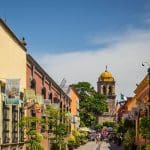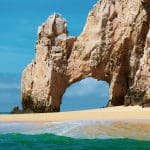Offering wildlife sightings comes natur(e)ally for some in tourism
Ian Stalker
Experience wildlife at Time + Tide resorts
Zambia
Time + Tide happily reports that the region around its Zambia property is looking a little greener these days, thanks to a recurring development provided by Mother Nature.
The company — which has a presence in both Zambia and Madagascar — released a video titled Voice of the Rains to mark the start of Zambia’s green season and the regeneration of the bush.

The moving video is narrated by a local, who invites viewers to “watch life begin” and showcases many of the animals found in Zambia’s South Luangwa River area, including lions, leopards, elephants and zebras.
The narrator notes that local landscapes turn from brown to green with rain’s arrival and while at the Time + Tide Resort at night guests can hear “the chorus of 1,000 frogs. This is the magic of the rain.”
Viewers are also invited to “explore areas others won’t tread,” perhaps seeing fresh leopard tracks and hearing lions roar while doing so.
“Face the stars and you will feel me,” the narrator adds, glancing up at overcast sky. “I am the voice of the rain.”
Encounter penguins in the wild
Adventure Canada
Adventure Canada is inviting people to see some of our flightless feathered friends.
The company is promoting 2022 Antarctica expeditions that Adventure Canada president Cedar Swan says can enable people to see birds that can waddle, slide and swim but can’t get airborne.
But their inability to fly doesn’t diminish the appeal penguins have always have, she adds.
 “I find that folks are often fascinated with penguins because they each have their own adorable personality,” Swan states. “In many ways, penguins remind us of ourselves. It is remarkable to witness them finding their partner by the sound of their call, feeding and caring for their chicks, or squabbling over a prized pebble. Although they are wild animals, their quirks and temperaments can seem very human. Personally, I don’t think I’ll ever get tired of spending time with penguins — they are amazing!”
“I find that folks are often fascinated with penguins because they each have their own adorable personality,” Swan states. “In many ways, penguins remind us of ourselves. It is remarkable to witness them finding their partner by the sound of their call, feeding and caring for their chicks, or squabbling over a prized pebble. Although they are wild animals, their quirks and temperaments can seem very human. Personally, I don’t think I’ll ever get tired of spending time with penguins — they are amazing!”
“If you are visiting Antarctica during the Southern Hemisphere summer, you will definitely get to see penguins. The exact species will vary depending on the season and where exactly you travel to. On South Georgia, you can find huge colonies of king penguins, the second-largest species in the world. On the Antarctic Peninsula, you’re most likely to find the gentoo, chinstrap, and Adélie varieties. The rarest to spot on a ship-based expedition is the regal emperor penguin; it doesn’t happen very often, and those who have seen them can consider themselves very lucky!”
Meanwhile, Swan says her company follows guidelines set by the International Association of Antarctica Tour Operators when it comes to having clients view penguins and “always respects wildlife when visiting their home. We always advise guests to maintain a five-metre distance from any wildlife for their own safety. That being said, penguins are extremely curious, and sometimes if you hang out close by they may wander over to find out what you’re up to. When the ship is cruising, we often joke that we can smell the penguin colonies before we can see them, so by the time we arrive you may decide that you don’t want to get so up-close-and-personal after all,” she adds.
Adopt a Coqui Frog
Discover Puerto Rico
Discover Puerto Rico has a message for those eager to help safeguard Puerto Rico’s natural side — hop to it!
Discover Puerto Rico, the island’s destination marketing organization, in partnership with local environmental research and conservation organization, Conservación ConCiencia, last month invited “everyone to give the gift of nature and Adopt a Coquí, supporting Puerto Rico’s natural resources. A symbol of Puerto Rico worldwide, the coquí is a species of frog endemic to the nature-rich Island, and heartfully named for the sound it makes. “Pent-up travellers staying safe at home during this time, but thinking about their first trip in 2021, can support global conservation while virtually learning and dreaming of a destination filled with natural wonders, and more,” the tourism board said.
 By visiting DiscoverPuertoRico.com/coquí and making a donation of US$25, coquí gift recipients receive a digital keepsake adoption certificate with their name on it for the contribution to supporting conservation, sustainability, and climate resilience efforts by Conservación ConCiencia.
By visiting DiscoverPuertoRico.com/coquí and making a donation of US$25, coquí gift recipients receive a digital keepsake adoption certificate with their name on it for the contribution to supporting conservation, sustainability, and climate resilience efforts by Conservación ConCiencia.
“We’re inviting future travellers to be inspired by our natural offerings in a safe and responsible way as many are dreaming about their first trip when the time is right,” Brad Dean, CEO of Discover Puerto Rico, said in December. “While Puerto Rico is ensuring the safety of residents and travellers alike and only recommending essential travel at this time, Adopt a Coquí gives the gift of hope during this holiday season, supporting conservation efforts in Puerto Rico and felt globally.”
Discover Puerto Rico says today’s traveler mindset has shifted, and as they look toward a safer time, many are leaning towards ways to be more mindful and create meaningful experiences. Besides spending time with loved ones, getting away from crowds and enjoying nature are highest priority among future travellers, according to a study by Destination Analysts.

Home to habitats like rainforests, pink salt flats, underground caves and more, Puerto Rico is billed as an ideal place to connect with nature in 2021. Adopt a Coquí supports the little frogs that impact the Island’s ecosystem, and although protected, are at risk due to loss of habitat and climate change. A cultural symbol in Puerto Rico since the times of the original indigenous Taino inhabitants, the coquís’ home can be found primarily in forest, such like El Yunque National Rainforest, the only tropical rainforest in the U.S. National Forest System. With 17 different species that inhabit Puerto Rico, when the sun goes down, male coquís begin singing their song that gives them their name (Co-Kee, Co-Kee) until dawn.
“Maintaining our natural habitats and ecosystems is imperative for both local and global impact,” said Raimundo Espinoza, founder of Conservación ConCiencia. “By implementing effective, science-based conservation initiatives, we help save our local marine resources and wildlife, including protecting our naturally unique coquís here in Puerto Rico, while moving societies towards sustainability.”
Make a splash at Xel-ha
Quintana Roo
Quintana Roo’s Xel-Ha park says visitors interested in nature will bee appreciative of its attractions.
Xel-ha Park is an eco-adventure water park that’s part of the Grupo Xcaret brand that offers the likes of water slides, snorkelling, rope swings and a visit to the remains of an ancient Mayan port city. It’s also billed as a snorkeler’s paradise, with Xel-ha’s inlet home to over 70 aquatic species ranging from stingrays to sea turtles, as well as a manatee sanctuary where park goers can admire them in their natural habitat.

Nature enthusiasts can also a botanical garden and a stingless bee sanctuary found at the park.
“This marvellous park is home for Queen Conch Sanctuary, a place where for more than a decade and along with prestigious universities, this species has been studied and being census of the specimens living at the inlet. Also, find an outstanding nursery that houses more than 270 species of native plants, some of them threatened by deforestation due to the urban growth and overexploitation of natural resources. Xel-Há has a strict relocation policy from many years ago to prevent development that affects flora,” the park says.
“Chacah’s Garden is another must-visit spot at the park where many famous guests were invited to plant one of these trees, which has major significance in the region and among the ancient Maya. Visit the Meliponary, which is a space with a colony of these stingless bees that was sacred for the former settlers and produces delicious honey. Twice a year, there is a traditional ceremony before starting the harvest season.”

















